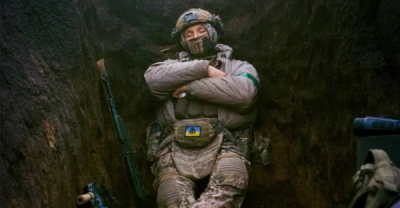NYT on Ukraine’s Nazi Imagery: It’s ‘Complicated’

All Global Research articles can be read in 51 languages by activating the Translate Website button below the author’s name.
To receive Global Research’s Daily Newsletter (selected articles), click here.
Click the share button above to email/forward this article to your friends and colleagues. Follow us on Instagram and Twitter and subscribe to our Telegram Channel. Feel free to repost and share widely Global Research articles.
***
The New York Times continued its line of downplaying—or even celebrating—Nazis in Ukraine with a piece (6/5/23) that sought to explain away the frequency of Nazi symbols in photographs of the Ukrainian military. The Times commented that such imagery put “Western journalists” in a “difficult position,” noting that a Ukrainian press officer said journalists had asked Ukrainian soldiers to remove Nazi insignia before being photographed.
The headline read: “Nazi Symbols on Ukraine’s Front Lines Highlight Thorny Issues of History.” The chief concern, per the Times subhead, was the worry that evidence of Nazism in Ukraine “risks fueling Russian propaganda.”
‘Complicated relationship’
At issue was “the Ukrainian military’s complicated relationship with Nazi imagery, a relationship forged under both Soviet and German occupation during World War II.” The relationship is “delicate,” the Times says, because of Putin’s stated war aims of de-Nazification.
Times reporter Thomas Gibbons-Neff dismisses the idea that Ukraine needed de-Nazification on the grounds that, despite its “acceptance” of Nazi symbols in many cases, current President Volodymyr Zelenskyy is Jewish. This weak argument is made weaker, given that, regardless of his heritage, it is well-documented that Zelenskyy sits at the center of a power structure in which far-right, neo-Nazi forces are a key constituency.
Igor Kolomoisky, one of Zelenskyy’s key supporters, was even a backer of the Azov Battalion—a group, once described by the Times (3/15/19) as a “neo-Nazi paramilitary organization,” that has been integrated into the Ukrainian military.
None of this justifies an illegal invasion. But it is clear that important facts have been deliberately suppressed or omitted within the US press (FAIR.org, 1/15/22), impairing readers’ understanding of the conflicts’ sources and possible resolutions.
The relentless threat of being labeled “Putin apologists” has created a chilling effect at even the highest liberal establishment organizations. Per the Times:
Even Jewish groups and anti-hate organizations that have traditionally called out hateful symbols have stayed largely silent. Privately, some leaders have worried about being seen as embracing Russian propaganda talking points.
The Times story acknowledged that journalists are worried about reporting reality, noting that at one point, according to a Ukrainian press officer, journalists from an unnamed outlet had soldiers remove Nazi symbols before they were photographed. This is a serious allegation of journalists knowingly distorting their portrayal of reality for explicitly political reasons.
Pioneering the Holocaust
The Times did find someone credentialed to legitimize running cover for Nazis:
Ihor Kozlovskyi, a Ukrainian historian and religious scholar, said that the symbols had meanings that were unique to Ukraine and should be interpreted by how Ukrainians viewed them, not by how they had been used elsewhere.
“The symbol can live in any community or any history independently of how it is used in other parts of Earth.”
The distinction drawn between how Nazi symbols were used in Ukraine as opposed to “other parts of Earth” suggests that Nazism in Ukraine was somehow more benign than in other places. To the contrary, Ukraine was where the mass slaughter of Jews was pioneered, with an estimated 1.5 million people killed there, or one in every four Jewish victims of the Holocaust. These killings were largely carried out by Ukrainian nationalist militias; survivors of these units that participated in the Holocaust were granted veteran status by Ukraine in 2019, making them eligible for government benefits (Kyiv Post, 3/26/19).
The CIA’s Nazis
As part of his defense, Kozlovskyi references the postwar anti-Soviet struggles of these Ukrainian nationalists:
Today, as a new generation fights against Russian occupation, many Ukrainians see the war as a continuation of the struggle for independence during and immediately after World War II.
Kozlovskyi and the Times omit the fascist character of this “struggle for independence.” Though it is rarely acknowledged today, the United States had a robust policy of training and equipping former Nazis in Western and Eastern Europe—by no means “unique to Ukraine”—to act as anti-Communist paramilitaries.
Ukraine saw former SS and Nazi intelligence units receive support from the CIA as part of the nationalist movement against Communism. The Nazis we see in Ukraine today are direct descendents of these networks and organizations. Even if the Times refuses to reference this history, these symbols have their roots explicitly in US-backed Nazi movements, making their defense of the current Nazis all the more egregious.
Like many facts in this war, the Ukrainian Nazi problem and its origins have been relegated to the memory hole by US corporate media (FAIR.org, 2/23/22). What’s striking is just how common it was for establishment press to acknowledge Ukraine’s Nazi problem before the war began—with the issue even recognized by the US Congress.
However, as the Times reporting has reinforced, US journalists have decided that being on the right team in this war is more important than presenting an accurate picture of events to their audience. This latest Times piece underscores the role journalists play in manufacturing consent for US policy on this and many other fronts, even if it means rehabilitating Nazi paramilitaries.
*
Note to readers: Please click the share button above. Follow us on Instagram and Twitter and subscribe to our Telegram Channel. Feel free to repost and share widely Global Research articles.
Bryce Greene is a writer based in Indiana.
Featured image: New York Times photograph of a Ukrainian soldier wearing a patch that incorporates the Nazi Totenkopf symbol.

